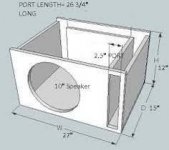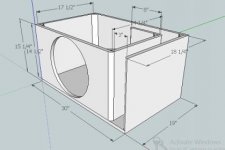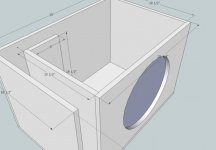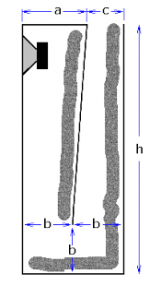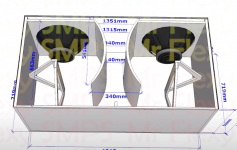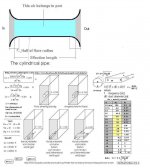Hello everyone
for the longest time i've been confused about port (lengths) / tuning.
If you have something like this:

Is the port this:

or does the corner belong to the port like

And how do you calculate oddly shaped ports like this: (where does the port start here?)
Can I just use the port volume in something like winISD and translate it to another shape and it will roughly behave the same way?

Another example would be the L-Acoustic KS21:
What is this port here?

Thanks 🙂
for the longest time i've been confused about port (lengths) / tuning.
If you have something like this:
Is the port this:
or does the corner belong to the port like
And how do you calculate oddly shaped ports like this: (where does the port start here?)
Can I just use the port volume in something like winISD and translate it to another shape and it will roughly behave the same way?
Another example would be the L-Acoustic KS21:
What is this port here?
Thanks 🙂
No kidding, i just wanted to send that picture 🤣
Yes thats all port. But all of that doesnt quite answer my question. I was talking specifically about "traditional" bass reflex
Yes thats all port. But all of that doesnt quite answer my question. I was talking specifically about "traditional" bass reflex
Ok thanks 🙂
and if we look at something like that:


First: I guess the corner belongs to the port aswell. But: If I use a speaker calculator and calculate a normal rectangle port. Can I just translate it without much trouble into a shape like this or do i need to calculate this differently?
and if we look at something like that:
First: I guess the corner belongs to the port aswell. But: If I use a speaker calculator and calculate a normal rectangle port. Can I just translate it without much trouble into a shape like this or do i need to calculate this differently?
Attachments
If the port doesn't flow smoothly as it would if it were straight then it could be hard to predict. Certainly losses may change, but there may also be different things happening at different frequencies. Breaking it down to a simple change in length may not be enough.
You'd be advised to measure it (acoustically/electrically).
You'd be advised to measure it (acoustically/electrically).
It is impossible to measure the acoustical length of a vent with a ruler. You always start with a good approximation, let's say the calculated length minus the diameter (the air in front and behind the vent creates a longer acoustical length). And then you measure. Fun fact: you only need signal generator that can be downloaded for free, plus a few grains of rice to do this measurement. Put the enclosure on it's back with the bass driver facing upwards, place some grains of rice on the cone. Now do a slow sweep around the region of interest. The point where the grains of rice move the least is the tuning frequency.
Isn't it then length plus diameter if the air in fron and behind create a longer length?You always start with a good approximation, let's say the calculated length minus the diameter (the air in front and behind the vent creates a longer acoustical length).
Thanks for the advice with the rice, i'll check that out
Depends which direction you're going:
If you're deciding what length of port to start with in a prototype design, you'd subtract the end correction (unless you've already calculated it using something like Bjorno's formulae as attached - note all of them have "minus k.Dv").
If you're trying to infer a tuning frequency from the fixed length already present on someone else's plan, you'd add the end correction.
HTH,
David.
If you're deciding what length of port to start with in a prototype design, you'd subtract the end correction (unless you've already calculated it using something like Bjorno's formulae as attached - note all of them have "minus k.Dv").
If you're trying to infer a tuning frequency from the fixed length already present on someone else's plan, you'd add the end correction.
HTH,
David.
Attachments
- Home
- Loudspeakers
- Subwoofers
- Port confusion
